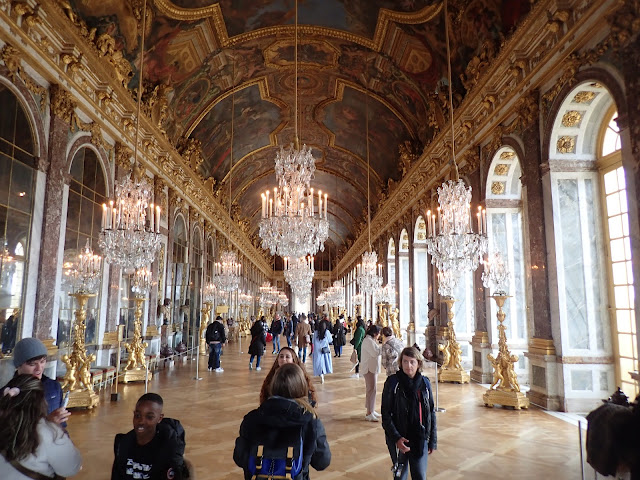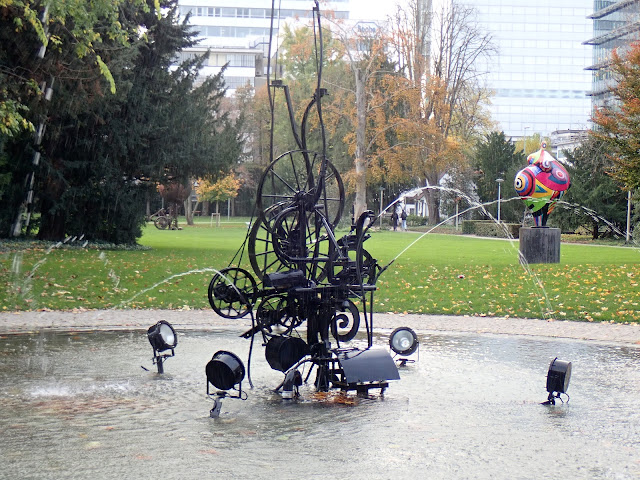Our return trip to Paris took us over 30 years, so it was definitely time to re-visit the City of Light. With light rain all 3 days it was a good thing we opted for a light schedule. Our first target was a 45 minute walk to the Musee d'Orsay, one of our favourite art museums. The museum, known for its impressionist painters (Monet, Matisse, Renoir. and many more) inhabited the former man railway station (1900-1977) and has 6 floors of impressive works. There was also an Edvard Munch (The Scream) exhibit going on, which made it clear that he should be known for much more than his most popular painting. The next day we took a train to Versailles to visit the Palace, which had escaped us the first time. The Palace is massive and features some of the finest French art from the 17th century with multiple paintings in the 50 or so rooms we were allowed to see (2300 rooms in total). Successive Kings enlarged and embellished the palace with every reign. but Louis XIV really put his stamp on the palace. It would take a full day to explore the palace Grand 'Apartments', the vast Gardens area (formerly a royal hunting ground), and the Estate of Trianon (which we ran out of energy to see). The opulence was a bit absurd, but displayed the power of the reigning kings at the time.
From Paris, we took the high speed 3 hour train, westward to Basel, Switzerland. We have been there more times than anywhere else in Europe, and rightly so, with our first born daughter living there with her Swiss partner. We were greeted with fondue dinner at their home, a nice Swiss start. The next day we visited the Tinguely Museum to discover more about this curious artist, who sculpted mechanical objects using recycled materials, mostly metals. His intent was to satirize automation and over-development waste. We had seen his famous Tinguely Fountain and were interested in finding out more about this creative soul. Our final day included a one hour trip to Zurich for a concert by the Irish rock band, Kodaline. They put on a great show in front of a sold out (1,500) crowd in a standing room only venue. A good time was had by all.
After our good-bye hugs, we flew from Basel to Amsterdam, where this journey started 2.5 months ago. At that time we spent our days roving around the Netherlands (south), saving some Amsterdam highlights for our final few days. The first of those was the Anne Frank House, which still needs to be booked in advance in order to gain entry. The former house where she hid from the Nazi's in the annex at the back of the home was crowded in the tiny rooms but like us, everyone wanted to capture every detail of this young icon's short life. It was haunting as visitors moved through the attic rooms in complete silence, with reality sinking in as the walls told the stories. While history is supposed to prevent us from repeating horrific events in our past, it is sad to see racial and cultural divides on the increase in today's world. Perhaps we need to listen to John Lennon's 'Imagine' non-stop for a few years. Museum day was destined for our final full day, as we headed straight for Museumplein (plaza). Rijkmuseum, the national art museum, featuring a vast number of paintings from the Dutch Golden Age (1584-1702). With over 8,000 pieces we tried to keep our focus on Rembrandt, Van Gogh and Vermeer, but there were many other great Dutch artist's works to be found. Overall, we spent close to 2 weeks in the Netherlands, and we really enjoyed our time there. With it's easily walkable terrain, picturesque canal scenes, cheese heaven and much more, a return visit may be in our future.
That brings to a close our 10 country, 77 day adventure to Europe and Egypt-Jordan. It was a wonderful experience involving many different cultures, and left us a bit weary by the end of it, but we have more special memories that will last forever. We are thankful for the opportunity we have been given to explore this wonderful world of ours.
 |
| In a city know for its incredible amount of bicycle traffic, this was a lovely Amsterdam street sighting. |









No comments:
Post a Comment